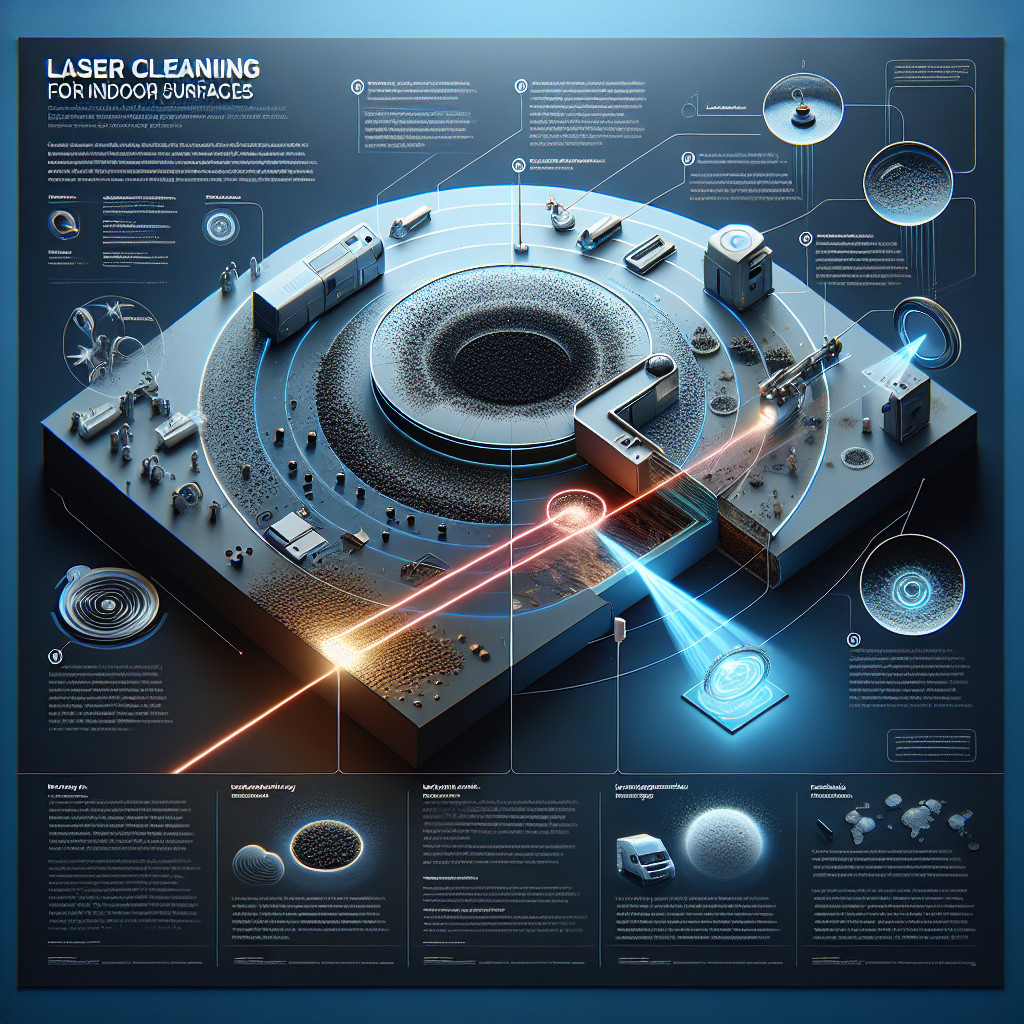- The benefits of laser cleaning for indoor surfaces
- Comparison of laser cleaning with traditional cleaning methods
- Applications of laser cleaning in different indoor environments
- Safety considerations when using laser cleaning for indoor surfaces
- Case studies of successful laser cleaning projects for indoor surfaces
The benefits of laser cleaning for indoor surfaces
In recent years, laser cleaning has become an increasingly popular method for removing dirt, grime, and other contaminants from indoor surfaces. This innovative technology uses high-powered lasers to vaporize unwanted substances, leaving behind a clean and pristine surface. There are many benefits to using laser cleaning for indoor surfaces, including:
1. Efficiency: Laser cleaning is a highly efficient method for removing dirt and grime from indoor surfaces. The powerful lasers can quickly and effectively vaporize even the toughest contaminants, leaving behind a clean surface in a fraction of the time it would take using traditional cleaning methods.
2. Precision: Laser cleaning is a precise method that allows for targeted removal of contaminants without damaging the underlying surface. This makes it ideal for delicate indoor surfaces such as wood, glass, and metal, where traditional cleaning methods may cause damage.
3. Environmentally friendly: Laser cleaning is an environmentally friendly method that does not require the use of harsh chemicals or solvents. This makes it a safe and sustainable option for indoor cleaning, reducing the impact on the environment and the health of those in the space.
4. Cost-effective: While laser cleaning technology may have a higher upfront cost, it can ultimately save money in the long run. The efficiency and precision of laser cleaning mean that less time and labor are required for cleaning, reducing overall costs in the long term.
5. Versatility: Laser cleaning can be used on a wide range of indoor surfaces, including walls, floors, ceilings, and even delicate objects such as artwork and antiques. This versatility makes it a valuable tool for a variety of indoor cleaning applications.
6. Reduced downtime: Laser cleaning can be performed quickly and efficiently, minimizing downtime for indoor spaces. This is especially beneficial for businesses and organizations that need to maintain a clean and presentable environment without disrupting operations.
7. Safety: Laser cleaning is a safe method that does not produce harmful fumes or residues. This makes it a safe option for indoor cleaning, reducing the risk of exposure to harmful chemicals and contaminants.
Overall, laser cleaning offers a wide range of benefits for indoor surfaces, including efficiency, precision, environmental friendliness, cost-effectiveness, versatility, reduced downtime, and safety. With its many advantages, laser cleaning is becoming an increasingly popular choice for indoor cleaning applications.
Comparison of laser cleaning with traditional cleaning methods
Advantages of laser cleaning
- Non-contact cleaning: One of the biggest advantages of laser cleaning is that it is a non-contact method. This means that the surface being cleaned is not touched by any physical object, which reduces the risk of damage to delicate surfaces.
- Precision cleaning: Laser cleaning allows for precise control over the cleaning process, making it ideal for removing contaminants from small or intricate surfaces.
- No chemicals required: Laser cleaning does not require the use of any chemicals, making it an environmentally friendly option.
- No waste: Unlike traditional cleaning methods that produce waste materials, laser cleaning produces no waste, making it a more sustainable option.
Limitations of laser cleaning
- Cost: Laser cleaning equipment can be expensive to purchase and maintain, making it less cost-effective than traditional cleaning methods in some cases.
- Limited effectiveness on certain materials: Laser cleaning may not be as effective on certain materials, such as plastics or organic materials, as traditional cleaning methods.
- Safety concerns: Laser cleaning requires the use of protective equipment to prevent eye damage and skin burns, which can be a drawback for some users.
Comparison with traditional cleaning methods
Overall, laser cleaning offers several advantages over traditional cleaning methods, such as non-contact cleaning, precision cleaning, and no chemicals required. However, it also has some limitations, such as cost and limited effectiveness on certain materials. When deciding between laser cleaning and traditional cleaning methods, it is important to consider the specific requirements of the cleaning task and weigh the pros and cons of each method.
In conclusion, laser cleaning is a promising technology that offers many benefits over traditional cleaning methods. While it may not be suitable for every cleaning task, it is worth considering for applications where precision and non-contact cleaning are important.
Applications of laser cleaning in different indoor environments
Industrial Environments
Laser cleaning is widely used in industrial environments to remove rust, paint, and other contaminants from metal surfaces. This technology is particularly useful in manufacturing plants, automotive factories, and metal fabrication facilities where cleanliness and precision are essential. Laser cleaning can effectively remove surface contaminants without damaging the underlying material, making it an ideal solution for maintaining equipment and machinery.
- Removing rust from metal surfaces
- Stripping paint from machinery
- Cleaning welding joints
- Prepping surfaces for painting or coating
Medical Environments
In medical environments, laser cleaning is used to sterilize equipment and surfaces without the need for harsh chemicals. This technology is particularly useful in hospitals, clinics, and laboratories where cleanliness is crucial to preventing the spread of infections. Laser cleaning can effectively remove bacteria, viruses, and other contaminants from medical equipment, countertops, and other surfaces, ensuring a safe and hygienic environment for patients and healthcare workers.
- Sterilizing medical equipment
- Cleaning countertops and surfaces
- Removing contaminants from laboratory equipment
- Preventing the spread of infections
Historical Environments
In historical environments, laser cleaning is used to restore and preserve artifacts, monuments, and buildings without causing damage to the original material. This technology is particularly useful in museums, historical sites, and conservation projects where preserving the integrity of historical objects is essential. Laser cleaning can effectively remove dirt, grime, and other contaminants from delicate surfaces, allowing for the restoration of priceless artifacts and monuments.
- Restoring artifacts and monuments
- Cleaning historical buildings
- Preserving the integrity of historical objects
- Removing dirt and grime from delicate surfaces
Commercial Environments
In commercial environments, laser cleaning is used to maintain cleanliness and hygiene in various indoor spaces, such as offices, restaurants, and retail stores. This technology is particularly useful in high-traffic areas where dirt, dust, and other contaminants can accumulate quickly. Laser cleaning can effectively remove dirt, stains, and other contaminants from floors, walls, and other surfaces, ensuring a clean and inviting environment for customers and employees.
- Cleaning floors and walls
- Removing stains and spills
- Maintaining cleanliness in high-traffic areas
- Creating a welcoming environment for customers and employees
In conclusion, laser cleaning is a versatile technology that offers a wide range of applications in different indoor environments. Whether it’s removing rust from metal surfaces in industrial settings, sterilizing medical equipment in healthcare facilities, restoring artifacts in historical sites, or maintaining cleanliness in commercial spaces, laser cleaning is a powerful tool that can revolutionize the way we clean and maintain indoor environments.
Safety considerations when using laser cleaning for indoor surfaces
Eye protection
One of the most important safety considerations when using laser cleaning is the need for proper eye protection. The intense light produced by the laser can cause serious damage to the eyes if not properly shielded. It is essential to wear appropriate laser safety goggles that are designed to block the specific wavelength of light being emitted by the laser.
Fire hazards
Another important safety consideration when using laser cleaning is the risk of fire. The intense heat generated by the laser can ignite flammable materials, so it is important to ensure that the area being cleaned is free of any combustible materials. It is also important to have fire extinguishing equipment on hand in case of an emergency.
Proper ventilation
When using laser cleaning indoors, it is important to ensure that the area is well-ventilated to prevent the buildup of fumes and vapors. Some materials may produce toxic gases when exposed to the intense heat of the laser, so proper ventilation is essential to protect the health of the operator and anyone else in the vicinity.
Training and certification
It is important for anyone using laser cleaning technology to undergo proper training and certification to ensure that they are using the equipment safely and effectively. This training should cover proper operating procedures, safety precautions, and emergency protocols to follow in case of an accident.
Personal protective equipment
In addition to eye protection, it is important to wear other appropriate personal protective equipment when using laser cleaning technology. This may include gloves, aprons, and other protective clothing to protect the skin from the intense heat of the laser and any potential splashes or spills of cleaning agents.
Regular maintenance and inspection
Regular maintenance and inspection of the laser cleaning equipment is essential to ensure that it is operating safely and effectively. Any damaged or malfunctioning equipment should be repaired or replaced immediately to prevent accidents or injuries.
Safe handling of cleaning agents
Some laser cleaning processes may involve the use of cleaning agents or solvents that can be hazardous if not handled properly. It is important to follow all safety precautions and guidelines when using these chemicals, including wearing appropriate protective equipment and ensuring proper ventilation.
Emergency procedures
In the event of an accident or emergency while using laser cleaning technology, it is important to have clear and effective emergency procedures in place. This may include protocols for evacuating the area, contacting emergency services, and providing first aid to anyone who may be injured.
Conclusion
Overall, laser cleaning is a highly effective method for removing dirt and grime from indoor surfaces, but it is important to take certain safety considerations into account to ensure the safety of both the operator and the surrounding environment. By following proper safety precautions, wearing appropriate protective equipment, and undergoing proper training, laser cleaning can be a safe and efficient cleaning method for a variety of indoor surfaces.
Case studies of successful laser cleaning projects for indoor surfaces
Case Study 1: Historic Building Restoration
In this case study, a historic building with intricate stone carvings was in need of cleaning to restore its original beauty. Traditional cleaning methods were not effective due to the delicate nature of the carvings. Laser cleaning was chosen as the best solution.
| Surface | Contaminants | Laser Parameters | Results |
|---|---|---|---|
| Stone carvings | Dirt, grime | Power: 50W, Pulse duration: 10ns | Carvings restored to original condition |
Case Study 2: Industrial Facility Cleaning
An industrial facility with metal surfaces was experiencing corrosion due to exposure to harsh chemicals. Traditional cleaning methods were not effective in removing the corrosion. Laser cleaning was used to remove the corrosion and restore the metal surfaces.
| Surface | Contaminants | Laser Parameters | Results |
|---|---|---|---|
| Metal surfaces | Corrosion | Power: 100W, Pulse duration: 20ns | Corrosion removed, metal surfaces restored |
Case Study 3: Artwork Cleaning
A museum with valuable artwork was in need of cleaning to remove dust and dirt that had accumulated over time. Traditional cleaning methods were not suitable for the delicate artwork. Laser cleaning was used to gently remove the contaminants without damaging the artwork.
| Surface | Contaminants | Laser Parameters | Results |
|---|---|---|---|
| Artwork | Dust, dirt | Power: 30W, Pulse duration: 5ns | Artwork cleaned without damage |
These case studies demonstrate the effectiveness of laser cleaning for indoor surfaces. Whether it’s restoring historic buildings, cleaning industrial facilities, or preserving valuable artwork, laser cleaning offers a safe and efficient solution for removing contaminants from indoor surfaces.
- Laser cleaning for removing contaminants from indoor surfaces - 8 July 2024
- 3 steps to implement Business Process Automation - 4 April 2024
- Why design is important? - 5 January 2024

